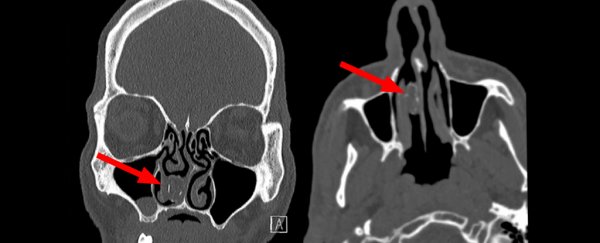Prisoners can be rather creative when it comes to smuggling in contraband. One such individual in Australia filled a balloon with marijuana and hid it inside his nasal cavity, successfully eluding detection. Clever, right?
Unfortunately, he was a little too successful - the mass stayed up there for nearly two decades.
The 48-year-old man's medical journey began with headaches that eventually saw him getting scans to uncover the underlying cause. After a few probing questions, he admitted he'd experienced a stuffy nose on the right side for years, as well as recurrent infections.
Scans revealed a "firm grey mass" in the man's right nasal cavity, so ear, nose and throat (ENT) specialists at Westmead Hospital in Sydney performed an endoscopy under general anaesthetic to remove it, revealing a "rubber capsule containing degenerate vegetable/plant matter".
Eventually, the medical staff heard the full story. When the patient was incarcerated at age 30, his girlfriend stopped by with a tiny gift. To get the small bag of marijuana past the guards, the inmate slipped the contraband up his right nostril.
Getting it inside was clearly easier than getting it out again. In trying to fish out the package, the man only pushed it further up his nose. At some point he became convinced the balloon had slipped back down his throat and was lost for good.
To be fair to the patient, losing track of a drug package is easy to do if you think you've accidentally swallowed it. But 18 years later, it gave his doctors a great 'world first' medical report to submit.
The technical name for the 1.9-centimetre-long (3/4 inch) mass physicians removed from the patient's right nasal cavity is a rhinolith. Which, if you know your Greek roots, translates into 'nose stone'.
That's a pretty solid description of what the rubber-and-plant-matter transformed into over the years. The composition of such nasal deposits varies from calcium oxalate to calcium phosphate, magnesium, or even iron compounds, and they can turn into stones as large as several centimetres (bigger than an inch).
Pulling hard, mineralised chunks of material from patient's noses isn't an everyday thing for ENTs, presenting in roughly 1 in 10,000 outpatients.
Only one other rhinolith based on smuggled drugs is recorded in the literature, which was revealed to be codeine and opium wrapped up in a scrap of nylon.
Far more common sources of rhinoliths are beads and seeds kids shove up their nostrils, blood clots, or even stray teeth. Try not to think too long on that last one.
Exactly why the body builds a concrete layer around objects isn't clear. We're trying hard not to see this as the human equivalent of an oyster's pearl, except infinitely more gross.
In most cases, it's not a comfortable affliction for the sufferer, coming with a host of symptoms such as a purulent nasal discharge, headaches, facial pain and foul smells.
Learning from this special case, the physicians note that rhinoliths should be considered any time a patient presents with symptoms that affect one side of the nose more than the other - even if it's not a weed balloon, there's still a chance something is stuck up there.
This research was published in BMJ Case Reports.
